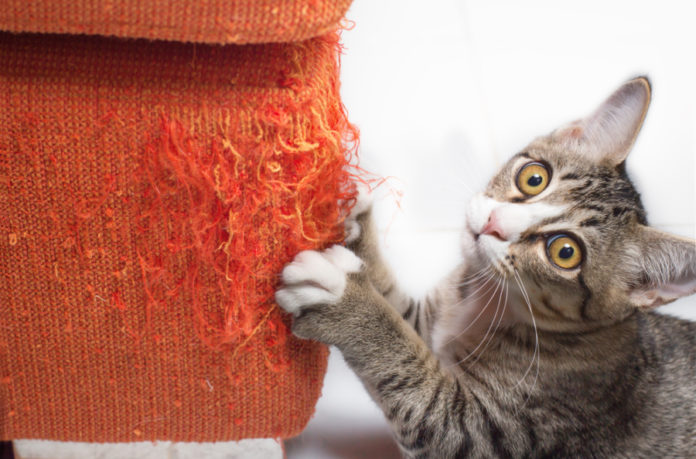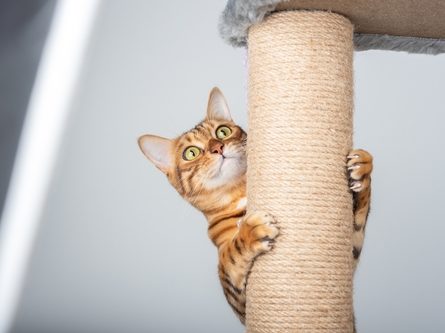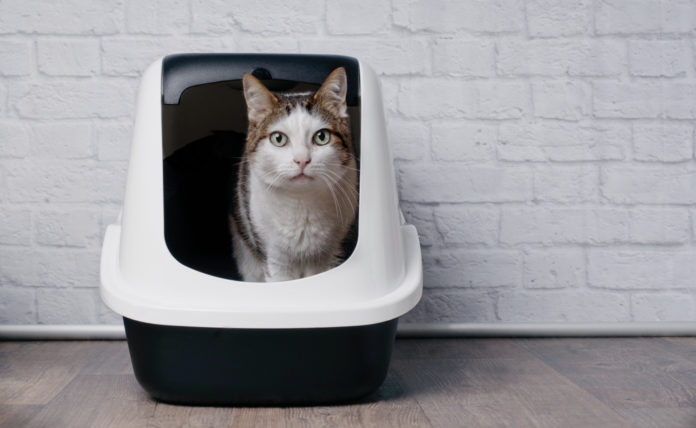Why Cats Scratch – It’s Only Natural

Anyone who has cats knows they love to scratch – often on inappropriate places such as the furniture. Contrary to what you may think, your cat doesn’t scratch just to be naughty.
She’s doing it because she needs to. Scratching is a natural instinctive feline behavior, which means it should be accommodated. Find out why cats need to scratch, and how you can fulfill her needs without sacrificing your furniture.
Cats scratch for four main reasons
“Asking a cat not to scratch is like asking a dog to never bark or a bird not to fly,” says Ingrid Johnson, a Certified Cat Behavior Consultant. Here are the four main reasons cats need to scratch:
- Nail health — Cats scratch to remove the outer dead sheaths on their nails, and uncover sharp new claws. “A cat’s nail grows in layers, like an onion, and it’s imperative that they remove the outer sheath to maintain nail health and prevent the nail from becoming embedded into the paw pad,” explains Ingrid.
- Territorial communication and scent-marking — Sweat and scent glands located between the pads of the cat’s feet produce pheromones. Scratching and discarded nail sheaths leave a visual mark, while the deposited pheromones leave a scent message for other cats. “Cats prefer to leave this scent in high-traffic, socially-significant areas,” says Ingrid.
- Stretching/exercising — Cats scratch in order to stretch, condition and flex their muscles from the front legs to the spine. Many cats scratch after waking or as part of their stretch sequence.
- Emotional well-being — Cats scratch because it’s a “feel good behavior,” says Ingrid. They also scratch when aroused or excited, or during play. Scratching may increase when your cat feels stressed or anxious or when her environment feels threatened.
Scratch this, not that
Scratching is a hard-wired feline behavior that cannot be “unlearned.” But cats can learn to scratch appropriate surfaces. First, make the targeted area unappealing, then provide a variety of more alluring scratching choices.
During the training period, it’s important to prevent access to the inappropriate scratching surfaces while teaching your cat what to scratch instead.
- “I recommend ‘booby trapping’ the items with something unpleasant, like double-sided sticky tape,” says Ingrid.
- You can also cover furniture with a plastic cloth, whole or cut to fit the area your cat favors, which is often the arm of a sofa or chair.
- Another suggestion is to spray the area with a synthetic pheromone that essentially sends a message to your cat saying: “You’ve already marked this spot.”
- Monthly nail trims help prevent damage, as does the use of nail caps, without stopping normal scratching behavior.
Set your cat up for scratching success
Provide appropriate, enticing scratching surfaces in the form of several scratching posts throughout the house. Always reward your cat when she uses them. Here are more tips for scratching success:
Size: “Scratching posts should be at least 30” tall and heavy enough that they don’t wobble or topple over when in use,” says Johnson.
wobble or topple over when in use,” says Johnson.
Shape: Most cats like to scratch vertically. However, some cats, especially seniors, prefer to scratch horizontally due to physical challenges such as arthritis. Other cats enjoy angled scratchers. Giving your cat a choice is key.
Texture: “Most cats prefer to scratch abrasive textures, which do the best job of removing the outer nail sheath,” says Ingrid. Preferred substrates include sisal rope, corrugated cardboard, carpet or wood. Let your cat choose.
Location: Most cats stretch and scratch after waking up, so put a scratcher near your kitty’s sleeping area. Also locate scratching posts in high-traffic areas that you and your cat pass through each day. “Look at your home as a series of highways,” advises Ingrid.
“Where are the intersections? That’s where your scratching posts should go! If your cat is already scratching someplace you wish she wouldn’t, you have your answer. She is telling you that this area is socially significant and that she needs to leave her scent there. Put a post there.”
Most cats stretch and scratch after waking up, so put a scratcher near your kitty’s sleeping area.
What not to do
Declawing your cat is never the solution. “Declawing is abhorrent cruelty,” Ingrid says. “It is the most painful procedure in veterinary medicine.”
Yelling or throwing things at your cat, or squirting her with water, won’t stop the scratching behavior — but it will increase fear and anxiety in your cat and fracture the bond between you. “I strongly encourage my clients to learn clicker training, and train their cats to use the scratching post, which takes all of ten minutes when you have the appropriate post,” says Ingrid. Then, embrace the ‘reward what you like and ignore what you don’t’ mantra to ensure you aren’t rewarding attention-seeking behavior by scolding the furniture scratching.”
Scratching is an instinctual behavior for our feline companions. It’s our responsibility as cat parents to provide them with the appropriate outlet for this natural behavior.




